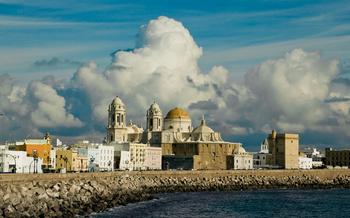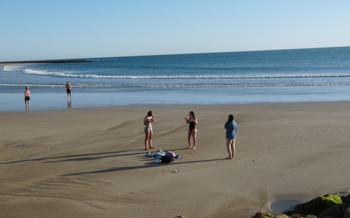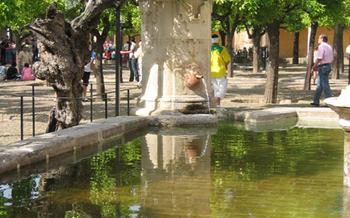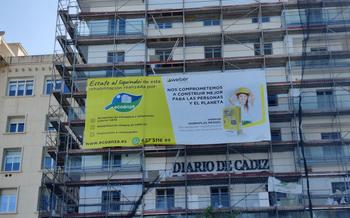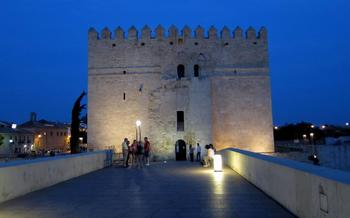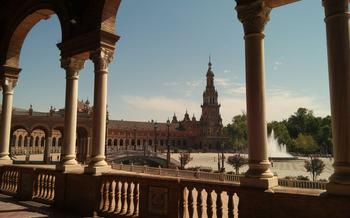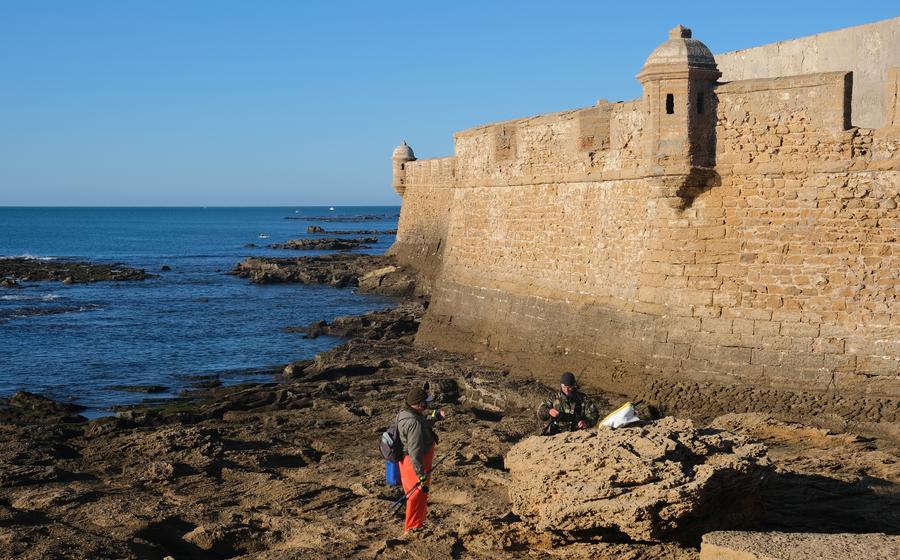
Castle of San Sebastián
- A Fortified Island
- Strategic Location
- The Castle's Construction
- The Tower of Tavira
- The Chapel of Our Lady of the Rosary
- The Drawbridge
- The Moat
- The Castle Museum
- Visiting the Castle
- Insider Tip
A Fortified Island
The Castle of San Sebastián stands proudly on a small island, connected to the mainland by a narrow causeway, in the picturesque bay of Cádiz, Southern Spain. Its strategic location and imposing fortifications have made it an important defensive outpost throughout history.
Built in the 13th century, the castle's origins can be traced back to the Phoenician settlement of Gadir, which later became the Roman city of Gades. Over time, it underwent several transformations, adapting to the changing needs of its occupants. In the 16th century, it was expanded and reinforced by King Philip II, who recognized its significance as a bulwark against potential attacks from the sea. Today, the castle serves as a popular tourist attraction, offering visitors a glimpse into its rich history and captivating legends.
Its architectural features showcase a blend of different styles, reflecting the diverse influences that have shaped Cádiz over the centuries. The sturdy walls, punctuated by imposing towers, exude an aura of resilience and strength. Inside, visitors can explore the castle's well-preserved chambers, each with its own unique story to tell.
Strategic Location
The Castle of San Sebastián occupies a strategic position at the entrance to the Bay of Cádiz, offering unparalleled views of the city and the surrounding area. This privileged location has played a crucial role in the castle's history, serving as a vital defensive outpost and a key player in maritime trade and commerce.
Control over the Bay The castle's strategic location allowed it to control access to the Bay of Cádiz, one of the most important natural harbors in southern Spain. This strategic advantage enabled the castle to oversee and regulate maritime traffic, ensuring the safety and security of merchant ships and naval vessels entering and leaving the bay.
Defense against Attacks The castle's position served as a formidable defense against potential attacks from seaborne invaders. Its commanding presence and powerful artillery batteries made it an intimidating force, deterring enemy ships from attempting to enter the bay or attack the city from the sea.
Role in Maritime Trade The castle's strategic location also played a vital role in maritime trade. Cádiz has long been a major port city, and the castle's position at the entrance to the bay allowed it to oversee and regulate maritime trade activities. The castle's cannons could be used to protect merchant ships from pirates and other threats, ensuring the safe passage of goods and promoting economic prosperity in the region.
The Castle's Construction
The origins of the Castle of San Sebastián can be traced back to the 13th century, when the city of Cádiz was under Muslim rule. The castle was initially built as a watchtower to protect the city from Christian attacks. In the 13th century, King Alfonso X of Castile conquered Cádiz from the Muslims and ordered the expansion of the castle. The castle was enlarged and reinforced, and new defensive features were added, such as a moat, drawbridge, and fortified walls. The castle played a crucial role in the Reconquista, the process of reconquering Spain from the Muslims. It served as a base for Christian forces and helped to secure the city of Cádiz from Muslim attacks.
The castle underwent several transformations and modifications over the centuries. In the 16th century, a new tower was added to the castle, known as the Tower of Tavira. The tower was used as a lookout post and for signaling ships. In the 18th century, the castle was remodeled and expanded once again. New barracks, storehouses, and other facilities were added to accommodate a larger garrison. The castle continued to be used for military purposes until the 19th century, when it was finally decommissioned and converted into a museum.
The Tower of Tavira
The Tower of Tavira, also known as the Torre Vigía, stands as a prominent landmark within the castle, an enduring testament to the rich history of Cádiz. Constructed in the 18th century, it served as a watchtower, vigilantly scanning the vast expanse of the ocean for approaching vessels, both friendly and hostile. The tower's elevated position afforded its sentries an unparalleled vantage point, allowing them to detect and communicate the arrival of ships long before they reached the shores of the city.
Over the centuries, the Tower of Tavira has undergone several transformations, adapting to the evolving needs and technologies of maritime surveillance. Initially conceived as a simple watchtower, it was later equipped with a camera obscura, a remarkable optical device that projected real-time images of the surrounding landscape onto a screen within a darkened chamber. This innovation revolutionized maritime surveillance, enabling observers to monitor the movements of ships with unprecedented precision and detail.
Today, the Tower of Tavira stands as a living museum, a captivating repository of Cádiz's maritime heritage. Visitors can ascend to the top of the tower and experience the same awe-inspiring views that once guided the city's defenders. The camera obscura, meticulously restored to its former glory, offers a unique and interactive glimpse into the past, allowing visitors to witness the bustling harbor and the distant horizon as if they were standing on the bridge of a ship.
The Chapel of Our Lady of the Rosary
Constructed in the 18th century, the Chapel of Our Lady of the Rosary is an architectural gem nestled within the confines of the Castle of San Sebastián. Its construction was driven by the need for a dedicated space for religious practices among the castle's inhabitants and garrison. Embracing the prevailing architectural style of the time, the chapel showcases a synthesis of Baroque and Neoclassical elements.
The interior of the chapel exudes a serene and sacred ambiance, enhanced by the soft glow of natural light filtering through the stained-glass windows. The altarpiece, a testament to the artistic prowess of local artisans, commands attention with its intricate carvings and vibrant colors. The centerpiece of the altarpiece is a stunning depiction of Our Lady of the Rosary, the patron saint of the chapel, surrounded by a celestial entourage.
Beyond its religious significance, the Chapel of Our Lady of the Rosary holds artistic value. The walls are adorned with frescoes and paintings that narrate biblical stories and depict scenes from the life of Christ. Each artwork is a testament to the skill and devotion of the artists who created them, adding to the chapel's rich cultural and historical tapestry.
During religious festivals and processions, the chapel becomes the heart of spiritual celebrations within the castle. The faithful gather to honor Our Lady of the Rosary, carrying her statue in a solemn procession through the castle grounds. These events are a testament to the enduring devotion of the local community and a vibrant expression of the area's cultural heritage.
The Drawbridge
The drawbridge of the Castle of San Sebastián is an impressive feat of engineering that has played a crucial role in the castle's defense throughout history. Constructed using sturdy materials and employing a sophisticated mechanism, the drawbridge allowed the castle's inhabitants to control access to the fortress, effectively preventing unauthorized entry and providing an additional layer of protection against enemy attacks.
Originally designed and built in the 13th century, the drawbridge has undergone several modifications and improvements over the years to enhance its functionality and effectiveness. Its mechanism, operated by a system of pulleys and counterweights, enables the bridge to be raised and lowered smoothly and efficiently. During times of peace or when expecting visitors, the drawbridge would be lowered to allow passage, while in times of danger or conflict, it would be raised to cut off access to the castle and protect its occupants.
The drawbridge's strategic importance in the castle's defense cannot be overstated. It served as a formidable barrier against enemy forces attempting to storm the castle, as they would be exposed and vulnerable while crossing the open bridge. The ability to raise the drawbridge quickly and effectively allowed the castle's defenders to isolate and repel attackers, making it a crucial component of the castle's defensive system.
Today, the drawbridge of the Castle of San Sebastián has been meticulously restored to its former glory, providing visitors with a glimpse into the castle's rich history and the ingenuity of its medieval builders. Visitors can marvel at the intricate mechanics of the drawbridge and appreciate its significance in the castle's defense, gaining a deeper understanding of the strategies and tactics employed to protect this important fortress.
The Moat
The Castle of San Sebastián is surrounded by a moat, a deep and wide ditch filled with water, that was created as a defensive measure to protect the castle from attacks. The moat was designed to make it difficult for enemies to reach the castle walls and to prevent them from undermining the foundations.
The water in the moat was supplied by a complex system of channels and reservoirs that collected rainwater and diverted it into the moat. This system ensured that the moat remained filled with water even during dry periods.
The moat was also used as a means of transportation. Boats were used to transport supplies and personnel between the castle and the mainland. The moat also served as a barrier to prevent the spread of disease and infection from the outside world.
Today, the moat is still visible, although it is no longer filled with water. The moat is a reminder of the castle's rich history and its importance as a defensive structure.
The Castle Museum
The Castle of San Sebastián also houses a museum that offers visitors a glimpse into the rich history and cultural heritage of the site. The museum's exhibits are housed in several rooms and galleries within the castle walls, showcasing a diverse collection of artifacts, documents, and interactive displays that bring the castle's past to life.
Among the highlights of the museum's collection are historical artifacts from various periods of the castle's existence, including Roman and Visigothic remains, medieval weapons and armor, and documents detailing the castle's role in the Reconquista and subsequent conflicts. Interactive displays and multimedia presentations provide visitors with an immersive experience, allowing them to learn about the castle's construction, its strategic significance, and the daily lives of its inhabitants.
The museum also hosts educational programs and workshops throughout the year, providing opportunities for visitors of all ages to engage with the castle's history and explore its cultural significance. These programs may include interactive activities, guided tours, and hands-on experiences that delve deeper into the castle's stories and legends, making it a great place to learn and discover for visitors of all ages.
Visiting the Castle
The Castle of San Sebastián is open to the public and offers a variety of ways to explore its rich history and stunning views. Here's what you need to know for your visit:
-
Opening hours: The castle is generally open from Tuesday to Sunday, with varying hours depending on the season. It's advisable to check the official website or local tourist information centers for the most up-to-date information.
-
Admission fees: There is a small admission fee for adults, with discounts for children, students, and seniors. It's worth considering purchasing a combined ticket that includes entry to other nearby attractions for a more comprehensive experience.
-
Guided tours: Guided tours are available in several languages and provide a deeper insight into the castle's history, architecture, and significance. Tours typically last around an hour and are led by knowledgeable and enthusiastic guides.
-
Self-guided visits: For those who prefer to explore at their own pace, self-guided visits are also an option. Informative panels and signage are placed throughout the castle, providing historical context and interesting facts.
-
Accessibility: The castle is partially accessible for visitors with disabilities. While some areas may be challenging to navigate, there are ramps and designated routes to ensure a comfortable and enjoyable experience for all.
-
Tips for planning your visit:
- To avoid crowds and enjoy a more serene experience, consider visiting during the off-season or on weekdays.
- Combine your visit to the castle with other nearby attractions, such as the Tavira Tower or the Museum of Cádiz, to make the most of your time in the area.
- There are several local restaurants and cafes in the vicinity of the castle, offering a range of culinary options to suit all tastes.
- Don't forget your camera to capture the breathtaking views and architectural details of this iconic landmark.
Insider Tip
-
Best time to visit for fewer crowds: To avoid the rush of visitors, it's advisable to visit the castle during the off-season, which runs from October to April. During this time, you'll encounter fewer crowds, allowing you to explore the castle's grounds and admire its features without feeling overwhelmed.
-
Combining a visit with other attractions: To make the most of your time in Cádiz, consider combining your visit to the Castle of San Sebastián with other nearby attractions. The city boasts several historical and cultural landmarks, including the Cádiz Cathedral, the Torre Tavira Camera Obscura, and the Museo de Cádiz. Plan an itinerary that allows you to explore multiple sites in one day, ensuring a comprehensive and enriching experience.
-
Local restaurants and cafes nearby: After exploring the castle, take advantage of the opportunity to savor the local cuisine at nearby restaurants and cafes. The area surrounding the castle offers a variety of dining options, ranging from traditional Spanish dishes to international fare. Indulge in mouthwatering seafood specialties, sample tapas at a local bar, or enjoy a leisurely meal with views of the ocean.
-
Photography opportunities: The Castle of San Sebastián presents numerous photo opportunities for capturing its architectural details, scenic vistas, and historical ambiance. Don't forget your camera to immortalize your visit and share your experiences with friends and family. Whether you're an amateur photographer or a seasoned pro, the castle's unique features will provide ample inspiration for your shots.
